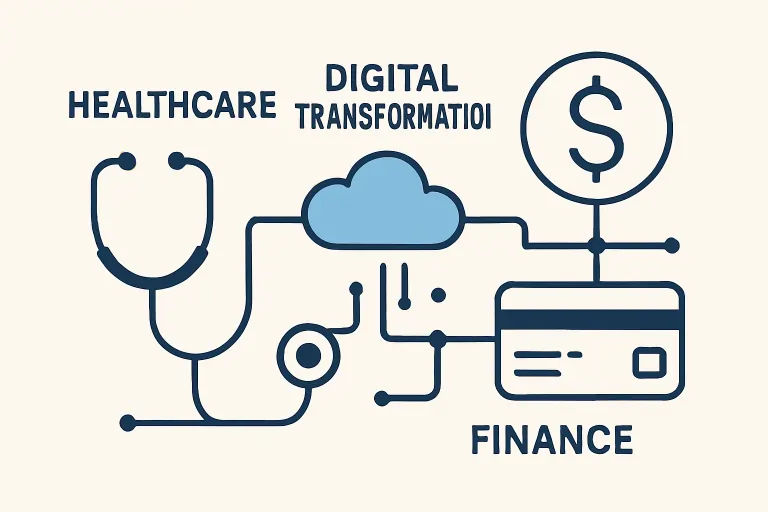Crafting Digital-First E-Commerce Strategies in Finance and Healthcare
Introduction
Digital transformation is no longer a far-off consideration for the finance and healthcare industries; it is a central part of modern service delivery. The move toward robust e-commerce strategies has been fueled by increasing consumer expectations for speed, convenience, and personalization. This shift demands technological adoption and a nuanced understanding of sector-specific regulations and customer needs. For example, leaders like Charles Nabit have tailored digital strategies to align with stringent compliance frameworks while enhancing customer experience and security in these sensitive fields.
With secure transactions and innovative digital experiences now paramount, organizations must balance leveraging the latest technology and maintaining trust. Regulatory compliance, privacy protection, and seamless care or financial service delivery are just a few of the core challenges that must be successfully navigated as companies invest in digital-first solutions. As providers navigate this landscape, a commitment to user experience and adaptive, data-driven operations sets leading brands apart in a competitive environment.
To create successful e-commerce strategies, finance and healthcare institutions are implementing advanced digital tools, personalizing user journeys, and investing in omnichannel integration. By evaluating operational needs and customer preferences and adopting best practices in technology and compliance, organizations can deliver digital offerings that delight customers while meeting industry regulations.
From real-time banking to telemedicine, the innovation curve continues to steepen. Proactive organizations focus on integrating advanced analytics and omnichannel communication, allowing them to evolve and meet customer demand rapidly. With consumer expectations shifting so quickly, adapting digital commerce plans is no longer optional for sustained success.
Understanding Industry-Specific Challenges
The finance and healthcare industries face intense regulatory scrutiny, creating complexities for digital-first e-commerce models. Besides safeguarding financial or medical records, providers must contend with widespread threats like data breaches and fraud. Financial e-commerce solutions must comply with regulations like the Dodd-Frank Act and CFPB directives, while healthcare providers face HIPAA and other patient privacy requirements. These standards demand robust strategies to handle not just digital access but also data governance, identity verification, and secure payment channels. As noted by Healthcare IT News, cybersecurity and compliance remain perennial concerns as financial transactions move online.
Integrating Advanced Technologies
Advanced technologies such as blockchain, artificial intelligence (AI), and the Internet of Things (IoT) have proven invaluable in both sectors. Blockchain creates immutable transaction records and enables secure interoperability of sensitive medical or financial data. AI is increasingly used for fraud detection, underwriting, and real-time risk assessment in finance, as well as patient monitoring, diagnostics, and appointment scheduling in healthcare. IoT devices enhance personalized healthcare by facilitating remote monitoring and timely interventions. The Qubit Capital emphasizes AI’s transformational role in financial services, particularly regarding automation and fraud detection.
Personalizing User Experiences
Modern consumers expect digital experiences that are not only fast and intuitive but also tailored to their individual needs. In healthcare, this means consolidating patient data into unified profiles and using analytics to direct care based on history and preferences. This approach improves outcomes and satisfaction. In finance, hyper-personalized dashboards, automated investment advice, and predictive alerts are becoming standard. Personalization is key to building trust and fostering loyalty, particularly in sectors where users are wary of digital interactions due to privacy concerns or past data misuse.
Ensuring Compliance and Security
Compliance and security form the backbone of all digital-first strategies in these sensitive sectors. Organizations must regularly audit their e-commerce solutions to identify vulnerabilities and meet requirements such as GDPR, PCI DSS, and other local or international standards. Encryption, two-factor authentication, and secure payment gateways are essential defenses. A proactive approach to evolving security threats is critical, as is ongoing employee training on digital safety and compliance updates, helping organizations guard against ever-changing cyber risks.
Leveraging Data Analytics
Data analytics unlocks enormous potential for both industries. Institutions can predict trends, optimize workflows, and deliver truly relevant offerings by capturing and analyzing customer behavior, spending patterns, and service interactions. Data-driven decision-making is essential for risk mitigation, resource allocation, and marketing strategy. In healthcare, analytics can identify gaps in care, reveal patient engagement opportunities, and inform staffing or supply chain improvements. In finance, analytics enhances fraud detection, credit scoring, and regulatory compliance through real-time reporting and trend analysis.
Adopting Omnichannel Approaches
Consumers today expect to interact with brands across multiple channels, including apps, web platforms, email, chat, and even phone or in-person visits. Omnichannel strategies offer consistent, integrated experiences that follow users as they move between devices or environments. For healthcare, this could mean telehealth appointments and online prescription renewals. For finance, unified digital branches and personalized support are now the norm. This seamless integration creates trust, drives engagement, and increases accessibility, dramatically improving the customer journey.
Continuous Monitoring and Adaptation
The digital ecosystem evolves rapidly, making continuous monitoring and strategic adaptation critical. Leading organizations constantly assess technological developments, shifting regulations, and customer feedback to refine their e-commerce offerings. Agile, data-driven frameworks allow for prompt pivots in response to new cyber threats or regulatory requirements, ensuring ongoing usability and compliance.
Conclusion
Digital-first e-commerce strategies transform finance and healthcare, enabling both industries to provide more secure, efficient, personalized services. Achieving excellence requires a deep understanding of regulatory landscapes, the integration of high-trust technologies, and a relentless focus on the user experience. By leveraging analytics, championing omnichannel experiences, and committing to innovation, organizations can thrive in an era where digital engagement is key to building lasting customer relationships and achieving long-term growth.
Read more: 5 Ways to Style Sneakers for Dressy Occasions – SizeCrafter
How to Safely Plan and Execute Home Demolition – SizeCrafter
Why Booking a Luxury Car for Your Wedding Adds Elegance and Style to the Big Day – SizeCrafter

